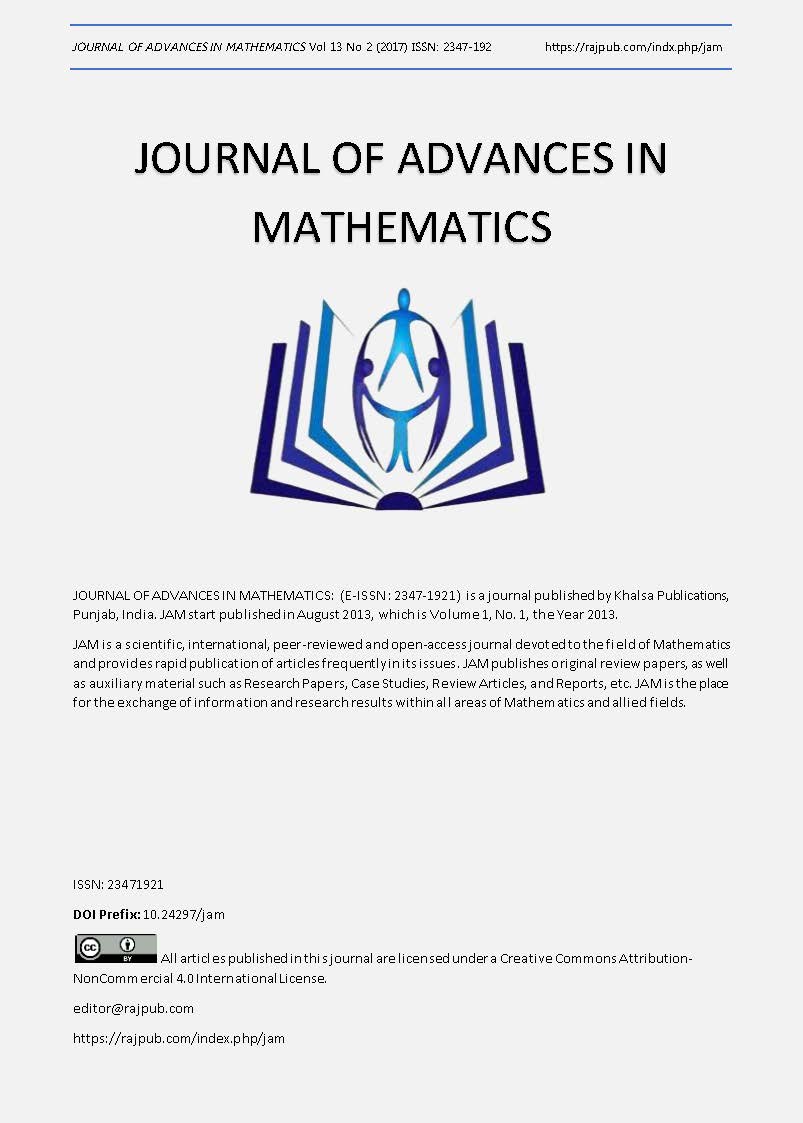ARBITRARY ORDER RECURSIVE SEQUENCES AND ASSOCIATED CONTINUED FRACTIONS
DOI:
https://doi.org/10.24297/jam.v13i2.6064Keywords:
Extension field, Jacobi-Perron algorithm, recurrence relations, Fibonacci numbers, Lucas functions, Kronecker deltaAbstract
The essential idea in this paper it to generalize and synthesize some of the pioneering ideas of Bernstein, Lucas and Horadam on generalizations of basic and primordial Fibonacci numbers and their arbitrary order generalizations and their relation to generalized continued fractions with matrices as the unifying elements.
Downloads
Download data is not yet available.
References
[1] Horadam, A.F. (1965) Basic Properties of a Certain Generalized Sequence of Numbers. The Fibonacci Quarterly. 3(4): 161-176.
[2] Ward, Morgan. (1931) The characteristic number of a sequence of integers satisfying a linear recurrence relation. Transactions of the American Mathematical Society. 33: 153-165.
[3] Horadam, A.F. (1965) Generating functions for powers of a certain generalized sequence of numbers. Duke Mathematical Journal. 32(3): 437-446.
[4] Williams, H.C. (1972) On a Generalization of the Lucas Functions. Acta Arithmetica. 20: 33-51.
[5] Bell, E.T. (1924) Notes on Recurring Series of the Third Order. Tôhoku Mathematical Journal. 24: 168-184.
[6] Kuhapatanakul, Kantaphon. (2015) The Lucas p-matrix. International Journal of Mathematical Education in Science and Technology. 46 (8): 1228-1234.
[7] Lucas, Edouard. (1878) Théorie des fonctions numériques simplement périodiques. American Journal of Mathematics. 1: 184-240, 289-321.
[8] Gootherts, G.W. (1968) A Lucas Algebra constructed from Fibonacci Sequences, Part I: Fundamentals and Polynomial Interpretations. The Fibonacci Quarterly. 6: 35-43.
[9] Dickson, L.E. (1952) History of the Theory of Numbers. Volume I. New York: Chelsea, Ch.XVII.
[10] Philippou, Andreas N. (1983) A Note on the Fibonacci Sequence of Order K and the Multinomial Coefficients. The Fibonacci Quarterly. 21(1): 82-86.
[11] Latushkin, Yaroslav, Vladimir Ushakov. (2009) A representation of recurrent sequences by previous terms. Congressus Numerantium. 194: 159-166.
[12] Brand, L. (1964) The Companion Matrix and Its Properties. American Mathematical Monthly. 71(6): 629-634.
[13] Barakat, Richard. (1964) The matrix operator eX and the Lucas polynomials. Journal of Mathematics and Physics. 43: 332-335.
[14] Macmahon, Percy A. (1915) Combinatory Analysis. Volume I. Cambridge: Cambridge University Press.
[15] Tee, Garry J. (1994) Prime powers of zeros of monic polynomials with integer coefficients. The Fibonacci Quarterly. 32(3): 277-283.
[16] Funkhouser, H. Gray. (1930) A short account of the history of symmetric functions of roots of equations. American Mathematical Monthly. 37(7): 357–365.
[17] Bernstein, Leon. (1971) The Jacobi-Perron Algorithm: Its Theory and Application. Lecture Notes in Mathematics, 207. Berlin: Springer Verlag.
[18] Shannon, A.G. (1976) Pellian equations and continued fractions. New Zealand Mathematics Magazine. 13(3): 113–115.
[2] Ward, Morgan. (1931) The characteristic number of a sequence of integers satisfying a linear recurrence relation. Transactions of the American Mathematical Society. 33: 153-165.
[3] Horadam, A.F. (1965) Generating functions for powers of a certain generalized sequence of numbers. Duke Mathematical Journal. 32(3): 437-446.
[4] Williams, H.C. (1972) On a Generalization of the Lucas Functions. Acta Arithmetica. 20: 33-51.
[5] Bell, E.T. (1924) Notes on Recurring Series of the Third Order. Tôhoku Mathematical Journal. 24: 168-184.
[6] Kuhapatanakul, Kantaphon. (2015) The Lucas p-matrix. International Journal of Mathematical Education in Science and Technology. 46 (8): 1228-1234.
[7] Lucas, Edouard. (1878) Théorie des fonctions numériques simplement périodiques. American Journal of Mathematics. 1: 184-240, 289-321.
[8] Gootherts, G.W. (1968) A Lucas Algebra constructed from Fibonacci Sequences, Part I: Fundamentals and Polynomial Interpretations. The Fibonacci Quarterly. 6: 35-43.
[9] Dickson, L.E. (1952) History of the Theory of Numbers. Volume I. New York: Chelsea, Ch.XVII.
[10] Philippou, Andreas N. (1983) A Note on the Fibonacci Sequence of Order K and the Multinomial Coefficients. The Fibonacci Quarterly. 21(1): 82-86.
[11] Latushkin, Yaroslav, Vladimir Ushakov. (2009) A representation of recurrent sequences by previous terms. Congressus Numerantium. 194: 159-166.
[12] Brand, L. (1964) The Companion Matrix and Its Properties. American Mathematical Monthly. 71(6): 629-634.
[13] Barakat, Richard. (1964) The matrix operator eX and the Lucas polynomials. Journal of Mathematics and Physics. 43: 332-335.
[14] Macmahon, Percy A. (1915) Combinatory Analysis. Volume I. Cambridge: Cambridge University Press.
[15] Tee, Garry J. (1994) Prime powers of zeros of monic polynomials with integer coefficients. The Fibonacci Quarterly. 32(3): 277-283.
[16] Funkhouser, H. Gray. (1930) A short account of the history of symmetric functions of roots of equations. American Mathematical Monthly. 37(7): 357–365.
[17] Bernstein, Leon. (1971) The Jacobi-Perron Algorithm: Its Theory and Application. Lecture Notes in Mathematics, 207. Berlin: Springer Verlag.
[18] Shannon, A.G. (1976) Pellian equations and continued fractions. New Zealand Mathematics Magazine. 13(3): 113–115.
Downloads
Published
2017-04-06
How to Cite
Shannon, A. G., Cook b, C. K., & Hillman c, R. A. (2017). ARBITRARY ORDER RECURSIVE SEQUENCES AND ASSOCIATED CONTINUED FRACTIONS. JOURNAL OF ADVANCES IN MATHEMATICS, 13(2), 7147–7154. https://doi.org/10.24297/jam.v13i2.6064
Issue
Section
Articles
License
 All articles published in Journal of Advances in Linguistics are licensed under a Creative Commons Attribution 4.0 International License.
All articles published in Journal of Advances in Linguistics are licensed under a Creative Commons Attribution 4.0 International License.








